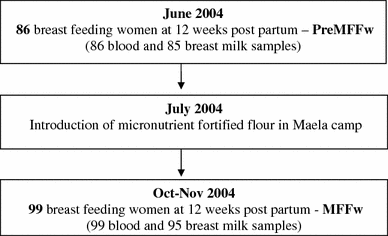Micronutrient status in lactating mothers before and after introduction of fortified flour: cross-sectional surveys in Maela refugee camp
- PMID: 21786020
- PMCID: PMC3366289
- DOI: 10.1007/s00394-011-0226-z
Micronutrient status in lactating mothers before and after introduction of fortified flour: cross-sectional surveys in Maela refugee camp
Abstract
Background: Deficiency of micronutrients is common in refugee populations.
Objectives: Identify deficiencies and whether provided supplements and wheat flour fortified with 10 micronutrients impacts upon status among breast-feeding women from Maela refugee camp.
Methods: Two sequential cross-sectional studies were conducted in different groups of lactating mothers at 12 weeks postpartum. The first survey was before and the second 4-5 months after micronutrient fortified flour (MFF) had been provided to the camp (in addition to the regular food basket). Iron status and micronutrients were measured in serum, whole blood, and in breast milk samples.
Results: Iron and zinc deficiency and anemia were highly prevalent while low serum retinol and thiamine deficiency were rarely detected. Iron and zinc deficiency were associated with anemia, and their proportions were significantly lower after the introduction of MFF (21 vs. 35% with soluble transferrin receptor (sTfR) >8.5 mg/L, P = 0.042, and 50 vs. 73% with serum zinc <0.66 mg/L, P = 0.001). Serum sTfR, whole-blood thiamine diphosphate (TDP) and serum β-carotene were significant predictors (P < 0.001) of milk iron, thiamine and β-carotene, respectively. Lower prevalence of iron deficiency in the MFF group was associated with significantly higher iron and thiamine in breast milk.
Conclusions: High whole-blood TDP and breast milk thiamine reflected good compliance to provided thiamine; high prevalence of iron deficiency suggested insufficient dietary iron and low acceptance to ferrous sulfate supplements. MFF as an additional food ration in Maela refugee camp seemed to have an effect in reducing both iron and zinc deficiency postpartum.
References
-
- Thailand Burmese Border Consortium (2006) Programme report for january–june 2006. ReliefWeb. http://www.reliefweb.int/rw/RWB.NSF/db900SID/ TKAE-6U49SV?OpenDocument. Accessed 5 Sep 2006
Publication types
MeSH terms
Substances
Grants and funding
LinkOut - more resources
Full Text Sources
Medical


